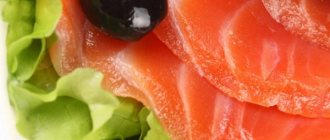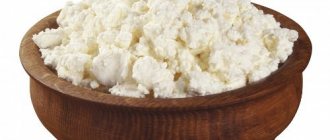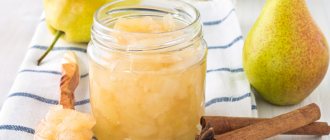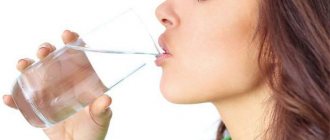Among the professional community of doctors and nutritionists, there have been many discussions about the importance of lard in the nutritional system and human health, and about how many calories are in lard.
For a long time it was believed that this product is difficult to digest by the body. It was recommended to exclude it from the diet or minimize consumption.
Today, views have changed radically.
Having analyzed the biological structure of the product and conducted clinical studies, foreign laboratories on nutrition have issued a verdict: “It is acceptable to use it in dietary nutrition for certain diseases, and it is allowed to be included in diets for weight loss if the dosage regimen is followed.”
The ban on lard has been lifted, but debates about the benefits and harms of this product are still ongoing.
Calorie content of lard
No one eats raw lard in its pure form. Usually, raw materials are purchased in order to independently prepare homemade delicacies from them. The fresh product can be smoked, pickled, pickled, or simply rolled into jars. Sometimes lard is rendered to produce lard. This option is an excellent substitute for vegetable oils. It is ideal for frying meat, frying first courses or potatoes.
Photo source: flickr.com
But how many calories are in raw lard? There are 798 kcal per 100 grams of such raw materials. At the same time, the ratio of BJU in lard is represented by the following figures:
- proteins - 2.5 g;
- fats - 90 g;
- carbohydrates - 0 gr.
Moreover, the calorie content of the same product with a layer is 620 kcal. There are no carbohydrates in it, but the combination of proteins and fats is 9 and 65 grams, respectively.
Lard is a product that consists almost entirely of fat and is completely devoid of carbohydrates.
How to choose

It turns out that not all lard is equally healthy. Researchers have calculated that the greatest benefit to the body comes from pork fat, which is found approximately 2.5 cm under the skin. The most delicious lard with the right consistency can be found in pigs fed on acorns. Very soft and loose is a sign that the pig was overfed with corn, and very hard fat will indicate that the animal was often malnourished.
If you want to buy a piece of salted pork product, then it is important to understand: after long-term storage, there is practically nothing useful left in it. Freshly frozen lard will bring more benefit. But if you have the opportunity to buy fresh, you should always give preference to it.
Calorie content of salted lard
Another popular type of product is salted lard. What is its energy value? The KBJU of the product without layers is represented by the following figures:
- kcal - 815.6;
- proteins - 1.4 g;
- fats - 90 gr.
There are no carbohydrates in the composition.
ABC RECOMMENDS

What is the calorie content of fried, raw, lean, stewed, boiled beef: composition, table and BJU per 100 grams
Calorie content of fried lard
No less common on our tables is fried lard - cracklings. They are often used to make scrambled eggs and fry potatoes. Usually, a small piece with or without a meat layer is used to prepare the dish.

Photo source: flickr.com
But to calculate your daily calorie intake, you need to know the calorie content of fried lard. There are 754 kcal per 100 grams, which is almost half of the daily calorie intake. For the same volume of cracklings, BZHU is expressed by the following indicators: 1.8/84/0.1 g.
The energy value and nutritional value of fried fat tail fat is even higher.
Experts' opinion

More and more doctors are speaking out in favor of lard, this is due to the fact that the composition of pork fat is unique. Thanks to its beneficial substances, the product helps normalize weight and improve health. According to nutritionists and gastroenterologists, for lard to help you lose weight, it must be consumed before 2 pm and in a minimum dose of 30 to 50 g.
According to a leading nutritionist, lard is an excellent product, but you need to take it in moderation. The diet of a young and an old, healthy and sick person is different. The amount of animal fat in the menu of a woman over 30 years old is 10% of total calorie intake. That is, out of 2000 kcal, she can consume 5 g of fat. Lard is especially useful in cold weather, it helps to keep you warm, defeat viruses, normalizes hormonal balance, and improves the skin. Lightly salted lard is considered the healthiest. Lidia Ionova, nutritionist
One of the best nutritionists in Moscow advises eating fresh lard. The daily allowance of lard is 30 g, best consumed before noon. But in order to get only benefits from the product, you need to choose a quality product, for this you need to pay attention to the following characteristics:
- Color. High-quality lard has a white or light pink tint. Avoid any product that is yellow, has reddish streaks, or contains blood.
- Smell. Natural lard has a light aroma. Do not buy a product with a strong odor.
- Documentation. Before purchasing, check the veterinary certificate, which will confirm that the product is safe. This is necessary, since lard can be infected with helminths.
Tatyana Zaletova, nutritionist
Calorie content of boiled lard
The most popular snack option is boiled lard. This is an original Russian product that has long been known in Slavic cuisine. But what is its energy and nutritional value? It is quite difficult to give exact numbers, since there are several recipes for preparing boiled lard. Carrots, garlic, spices, and pepper are added to the preparation.
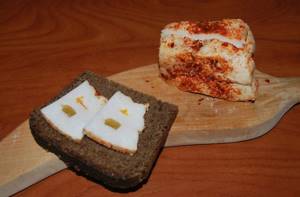
Photo source: flickr.com
So, 100 grams of boiled lard contains an average of 460 kcal. The nutritional value of the product is represented by the following ratio:
- proteins - 2 g;
- fats - 50 g;
- carbohydrates - 0 gr.
During cooking, lard loses some of its nutritional value as the raw material melts. This is the most “dietary” product.
Fat in folk medicine
Pork fat was used as a medicine back in Rus'. Some of the ancient recipes have survived to this day. Here are some of the most popular.
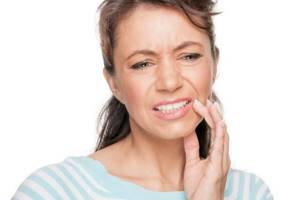
For toothache – apply a slice of unsalted lard to the gum near the sore tooth for 20 minutes.
For heel spurs - apply a piece of white fat to the sore spot and secure with a bandage.
For joint pain, apply a paste of ground lard and honey to sore areas at night (wrap with a warm cloth).
For warts - apply a mixture of melted lard (2 parts) and garlic (1 part) to the wart several times a day.
For varicose veins, wrap unsalted slices on painful areas.
For eczema - lubricate with a mixture of lard (2 tbsp), chicken proteins (2 pcs.), nightshade (100 g) and celandine juice (1 l). Before use, the product is infused for 3 days.
For calluses and corns, apply gruel from lard to steamed skin, then rub with pumice.
For back pain, wrap a piece of salted lard and wrap it in a warm scarf.
Composition and nutritional value of lard
All properties of lard directly depend on the chemical composition. Internal lard contains unsaturated fatty acids and various vitamins. Also, the composition of sebum is enriched with other beneficial substances:
- arachidonic acid (controls liver function);
- phosphorus;
- calcium;
- copper;
- potassium;
- selenium;
- vitamin A (good for vision and skin);
- vitamin E (participates in the process of hematopoiesis, rejuvenates the skin);
- vitamin D (regulates calcium and phosphorus metabolism, strengthens bones);
- a complex of polyunsaturated fatty acids, which includes linolenic, oleic and palmitic acids, which are incredibly beneficial for the health of women and men.
Sodium and iron were also found in the natural product. All these substances have a beneficial effect on human immune functions.
ABC RECOMMENDS

Boiled potatoes: calorie content, benefits and harms, nutritional value
Daily intake of lard
It is believed that if you consume salted lard in moderation, it will not cause harm to the human body. Is this true or a myth? If there are no serious health problems, such as diabetes or obesity, then this is true.

Photo source: flickr.com
But how much lard can you eat per day? The daily consumption rate of bacon fat without a layer for an adult is 30 grams. This is the minimum allowable volume. The main thing is not to exceed the threshold of 40 grams, otherwise you may encounter unpleasant and even dangerous health consequences.
The benefits and harms of lard
The main value of bacon is its ability to maintain the tone of the human body and strengthen immune functions. A small amount of lard (20-30 grams) provides good energy support in difficult conditions and during enormous physical exertion.
Among other beneficial properties of bacon, it is worth noting:
- acceleration of metabolism;
- regulation of brain activity;
- lung function support;
- improved digestion due to the enzymes contained in the composition;
- normalization of hormonal levels;
- strengthening the immune system.
It is also responsible for vascular health, prevents the formation of harmful cholesterol, and participates in the process of hematopoiesis. Lard is incredibly useful for women, including pregnant women (but strictly in limited quantities). The delicacy ensures the production of a special hormone estrogen, which is responsible for reproductive function.
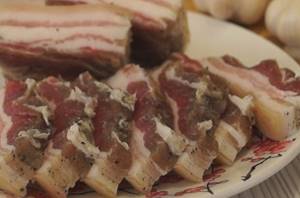
Photo source: flickr.com
Lard also improves the condition of hair and skin. Provides the body with energy in difficult life situations and during hard work. Relieves a person's condition during a hangover. Relieves fatigue and tension from the eyes, improves vision at dusk.
But not everything is so harmless. If you use bacon without restrictions, then it will bring nothing but harm to the body. There are other restrictions on introducing a product to the menu. Contraindications for use include:
- chronic pancreatitis;
- obesity;
- diabetes;
- cholecystitis in the chronic stage.
People with an allergy to lard and pathology of enzyme production should also give up lard, since they simply cannot process it.
ABC RECOMMENDS
What is the calorie content of borscht per 100 grams: BJU for borscht with beef, chicken, pork, without meat
What products are best combined with?
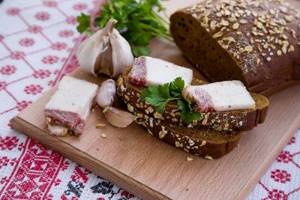
The ideal combination is lard with black bread and garlic. These products contain a high content of the component selenium, which is especially necessary for maintaining the health of pregnant women, nursing mothers and athletes.
According to the Institute of the Russian Academy of Medical Sciences, most Russians experience a deficiency of the element, which is manifested by increased nervousness, emotional instability, hair loss, and chronic fatigue. Lard with garlic will prevent cholesterol from damaging blood vessels and rid the body of toxic compounds.
A piece of bacon diversifies the taste of cabbage soup, solyanka, stewed carrots and beets, especially if it is used as a snack with vegetable dishes.
If you are obese, it is better to eat bacon with vegetables, for example, cabbage salad. You can add a spoonful of apple cider vinegar to it, this will additionally saturate the body with antioxidants.
You can use bacon as a snack during working hours. It is perfectly absorbed, dulls the feeling of hunger and increases performance. This afternoon snack will be much healthier than a sausage sandwich or a bun.
Calorie table
If you strive to clearly and competently calculate your daily caloric intake, you need to know the energy value of various types of lard. The table will help you with this:
| The product's name | Calorie content per 100 g (kcal) |
| Beef lard | 854 |
| Raw pork from the back | 812 |
| Raw pork belly | 857 |
| Lamb lard | 902 |
| Salted lard with seasoning without skin | 841 |
| Baked with juniper | 355 |
| Homemade smoked with garlic | 490 |
You will learn how to deliciously pickle salsa from the video recipe:


